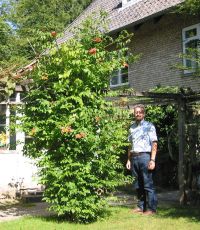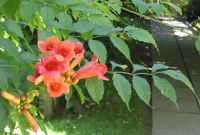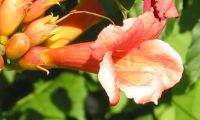Trumpet creeper, trumpet vine - Campsis radicans
English name:
Trumpet creeper, trumpet vine
Scientific name:
Campsis radicans
Family:
Bignoniaceae (Bignonia, or Trumpet-creeper)
Height:
10 M (climber)
Flowering:
mid August to end of September
Range:
southeast U.S.A.
 |
 |
 |
The 25 year old Campsis radicans in the top picture is from wild collected seed received from Morton Arboretum, Lisle, Illinois, USA. The plant can be found near the SW corner of the Dendrology House: square 1017, position 1007.
Plant description:
The genus Campsis contains 2 species, one from North America and the other from China. The name is derived from the Greek word kampsis for curved, referring to the curved stamens. This is possibly an adaptation to bird pollination along with the large size, trumpet shape and bright red colour of the flowers. The Chinese species is pollinated by perching birds and the American species by hummingbirds. Like Hedera (ivy), they are climbers that use aerial roots to attach to surfaces such as tree trunks or walls. Ants are attracted to nectar producing glands on the vegetative parts of the plant as well as to the flowers. This reduces herbivore attack. The pinnate, compound leaves are opposite on the twigs. We have only one species of Campsis in our collection since the Chinese species is not hardy enough to grow outdoors in Denmark. We have 3 specimens of Campsis radicans from one provenance, growing in a sheltered spot behind our Dendrology house.
Campsis radicans was also known as Tecoma radicans. The species name, radicans, is derived from taking root (from the roots readily produced on the stems). This species has been cultivated in England since1640, but first recorded as growing in Denmark in 1780. In spite of its long cultural history it is not a common garden plant. Our oldest living specimens are from 1980. Specimens are also found in the Copenhagen Botanic Garden.
Campsis radicans is a vigorous deciduous climber with compound leaves. Twigs are light brown. The 15 to 35 cm long leaves are pinnate and have 7 to 11 egg-shaped leaflets. The leaflets have with saw-toothed margins. They are hairless on top but downy beneath along the veins. Leafing out is late in Denmark. Flowers are produced at the end of the current years shoots in clusters of up to 12. The corolla is rich scarlet and orange, trumpet-shaped with 5 broad, irregular, rounded lobes. They open successively giving a long period of flowering. The fruit is a conspicuous brown pod, but I have never seen one produced on our plants.
The strikingly beautiful flowers of this vine as well as the lush green foliage must have attracted Europeans, soon after they began to settle in the USA. It is certainly worth growing in Denmark if one has a sheltered spot with deep loamy soil. Named cultivars exist for both the pure species and for hybrids between the two species. The hybrid needs more warmth than C. radicans but perhaps not as much as its Chinese parent. Plants can be regenerated using root-cuttings in autumn, or from cuttings of soft, shoots in mid-summer.
References:
Bean, W.J. 1976 Trees and Shrubs Hardy in the British Isles Vol I. A-C. Bean and Murray publishers. 845 pp.
Lange, J. 1994. Kulturplanternes Indførselshistorie i Danmark. (Introduction History of Cultivated Plants in Denmark). Jordbrugsforlaget, Frederiksberg. 458 pp.
Mabberley, D.J. 1998. The Plant Book. The Bath Press, Bath, 858 pp.
Olsen, O. et al. 1997 Havens Planteleksikon. Træer og Buske. (Danish Plant Encyclopaedia, Trees & Bushes). Det Danske Haveselskab Publisher, 674 pp.
Plants For A Future: https://pfaf.org/user/Default.aspx
